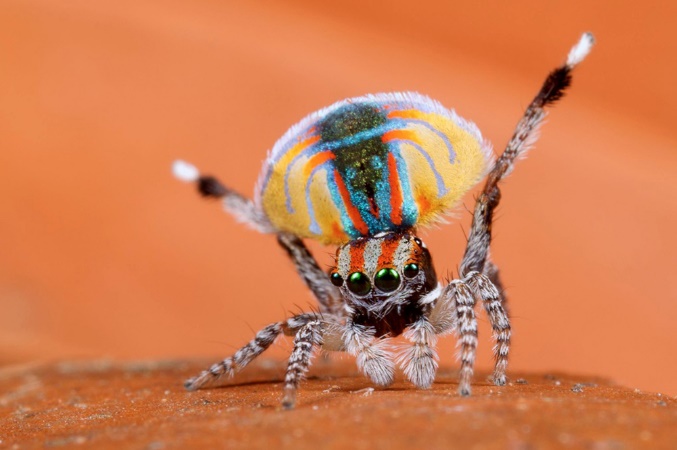Spider Mating Ritual Research

As shown in picture 1, male peacock spiders have a bright and colorful appearance, designed to attract females (Antonsen, 2019). However, their fascinating looks are only the tip of the iceberg, as these creatures have a whole slew of moves and signals aimed at gaining the attention of a potential mate.
The mating process starts with finding a female, which can be done by signaling with the legs, as shown in picture 1. Once a female is found, the male has to impress her, or she will consume him (Peacock Spider Mating Dance, 2017). The male begins the ritual by attracting the attention of the female. Once she is focused on him, he begins his dance, which consists of showing different parts of his body until the female returns a response (Bailey, 2019). The males of these species are known to be aggressive in their pursuit of a partner, so they often try to court a female that is not interested in mating. If that is the case, she might simply signal that by showing her abdomen, or she might eat the male if she is feeling hungry or annoyed (Bailey, 2019). If the female is satisfied with the male’s performance, they will mate. However, she might still eat the male afterward, as she needs the nutrients to produce and feed her offspring.
The pregnant female eventually lays a sack of eggs, where her spiderlings continue to develop until they are ready to burst into the outside world. Seeing as adult peacock spiders are already among the smallest creatures found in nature, their newly hatched children are too small and weak to survive on their own. The female guards and feeds her brood until they grow enough to be able to live independently (Bailey, 2019). The male spiderlings mature quicker than the females, who need more time to grow to their larger size. Relatively quickly, the males become ready to reproduce, and the cycle repeats itself.
Mating Dance and Song
For my own spider mating dance, I have chosen the popular “Despacito” by Luis Fonsi as the music. This song has a gradually accelerating rhythm that fits the intense nature of a spider-mating dance. The lyrics are also perfect for this application, as they express affection and desire, not to mention that they are written in the language of passion. A spider mating dance is much more primal than any product of human culture can ever be, but this song captures the excitement and suspense of this ritual and transforms them into human emotions.
References
Antonsen, A. (2019). Show or Tell? Testing Peacock Spiders’ Multi-Modal Mating Display. Entomology Today. Web.
Bailey, R. (2019). Peacock Spider Facts. ThoughtCo. Web.
Nature on PBS. (2017). Peacock Spider Mating Dance. Web.